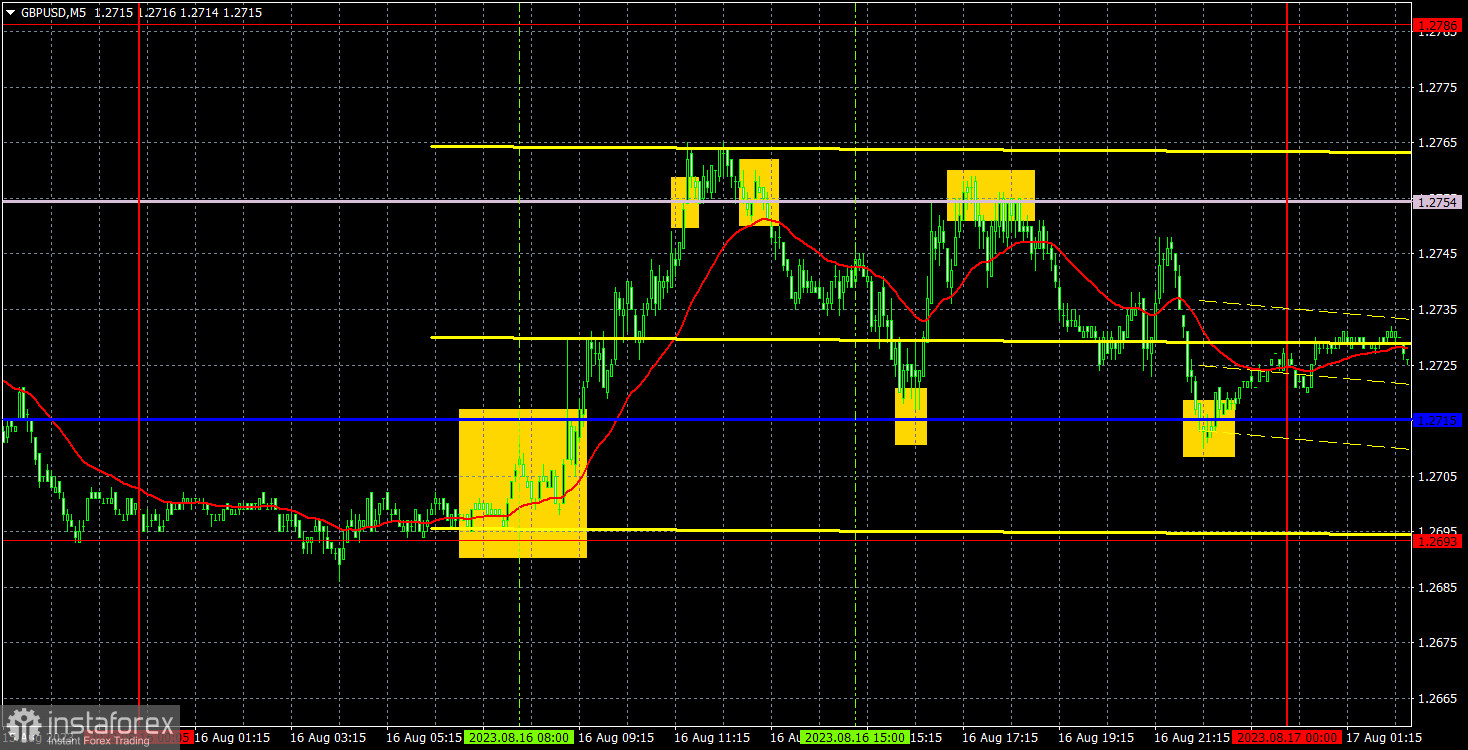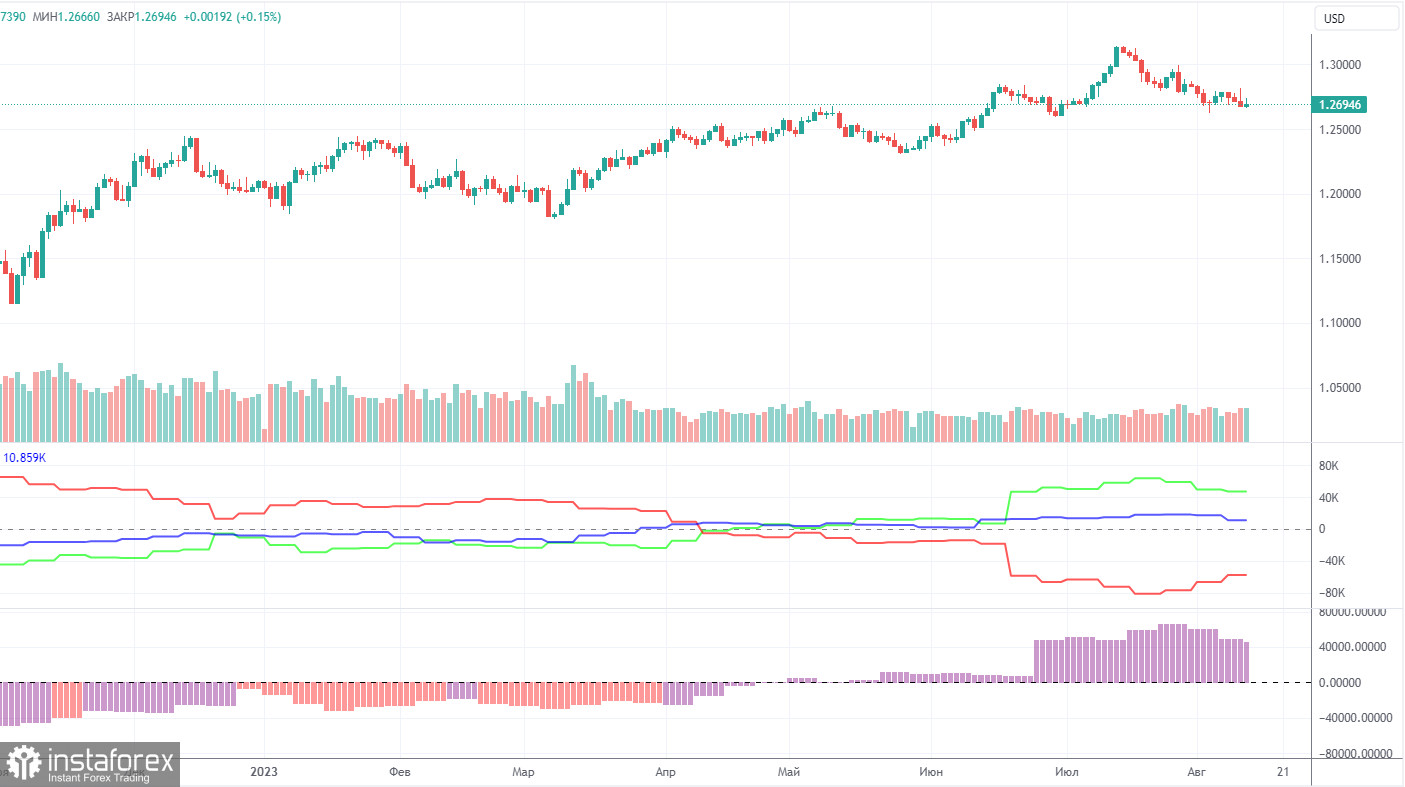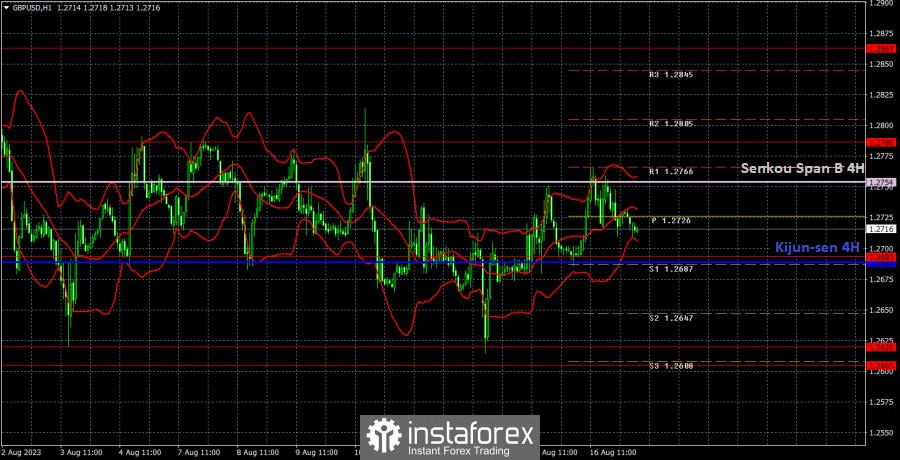Analysis of GBP/USD 5M

On Wednesday, GBP/USD traded higher, unlike the EUR/USD. It was another low-volatility day, and although the growth was modest, the pound was still rising for the second consecutive day, while the euro was falling. This can be explained by the economic reports. The UK released important reports on Tuesday and Wednesday. And although not all of them supported the British pound, the market still had formal reasons to buy the pair.
The headline Consumer Price Index fell to 6.8% in July, while core CPI remained unchanged at 6.9%. We could say that the market already expected such figures, so it is extremely difficult to characterize the reports as positive or negative. The fact that core inflation did not even fall by 0.1% slightly increases the chances of additional rate hike from the Bank of England, but not too much. Therefore, the pound only received weak market support, and in the second half of the day, it fell more than it rose.
There were plenty of trading signals yesterday. The pair spent the whole day between the Senkou Span B and Kijun-sen lines, bouncing off one and then the other. Therefore, traders could only trade within the boundaries of this sideways channel. This way, one could earn about 80 points since four trades were opened, and all four allowed earning 20 points each.
COT report:

According to the latest report, the non-commercial group of traders closed 8,900 long positions and 6,300 short ones. Thus, the net position of non-commercial traders fell by almost 2,600 positions in a week. The net position has been steadily growing over the past 11 months as well as the pound sterling. Now, the net position has advanced markedly. This is why the pair will hardly maintain its bullish momentum. I believe that a long and protracted downward movement should begin. COT reports signal a slight growth of the British currency but it will not be able to rise in the long term. There are no drivers for opening new long positions. Slowly, sell signals are emerging on the 4-hour and 24-hour charts.
The British currency has already grown by a total of 2,800 pips, from its absolute lows reached last year, which is a significant increase. Without a downward correction, the continuation of the uptrend will be illogical. However, there has been no logic in the pair's movements for quite some time. The market perceives the fundamental background one-sidedly, ignoring any data in favor of the dollar. The Non-commercial group of traders has a total of 83,200 long positions and 36,200 short ones. I remain skeptical about the long-term growth of the pound sterling, and the market has recently begun to pay attention to short positions.
Analysis of GBP/USD 1H

On the 1H chart, the pound/dollar pair continues to trade within a sideways channel. The channel has slightly expanded, so this doesn't mean that the flat has ended. The lines of the Ichimoku indicator are currently weak, but they worked very well in the market yesterday. However, false and inaccurate signals may form around them.
On August 17, traders should pay attention to the following key levels: 1.2520, 1.2605-1.2620, 1.2693, 1.2786, 1.2863, 1.2981-1.2987, 1.3050. The Senkou Span B (1.2754) and Kijun-sen (1.2689) lines can also be sources of signals, e.g. rebounds and breakout of these levels and lines. It is recommended to set the Stop Loss orders at the breakeven level when the price moves in the right direction by 20 pips. The lines of the Ichimoku indicator can move during the day, which should be taken into account when determining trading signals. There are support and resistance levels that can be used to lock in profits.
On Thursday, no important events lined up in the UK. The US will only release a minor report on unemployment benefit claims. Therefore, there is an extremely low chance that the price will leave the sideways channel today.
Description of the chart:
Support and resistance levels are thick red lines near which the trend may end. They do not provide trading signals;
The Kijun-sen and Senkou Span B lines are the lines of the Ichimoku indicator, plotted to the 1H timeframe from the 4H one. They provide trading signals;
Extreme levels are thin red lines from which the price bounced earlier. They provide trading signals;
Yellow lines are trend lines, trend channels, and any other technical patterns;
Indicator 1 on the COT charts is the net position size for each category of traders;
Indicator 2 on the COT charts is the net position size for the Non-commercial group.





















